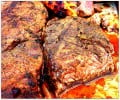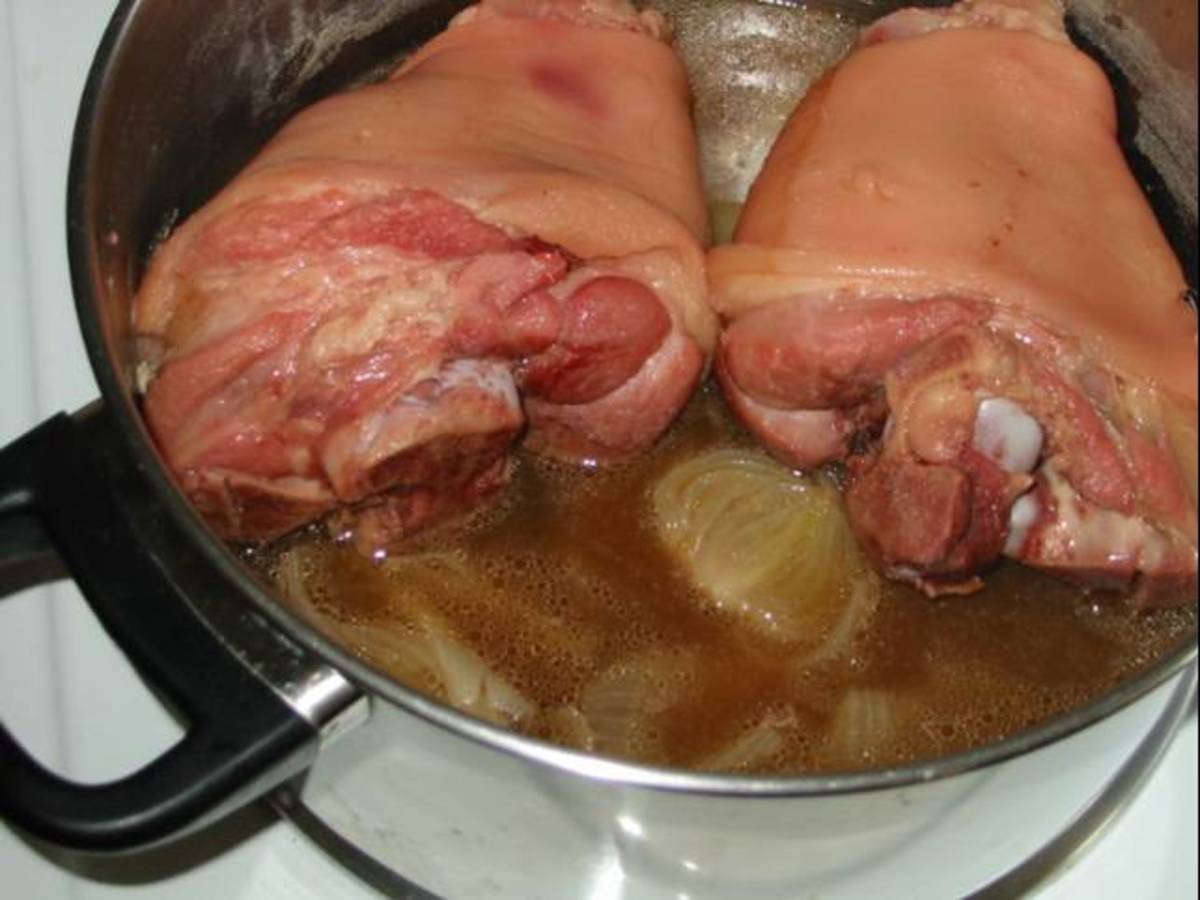Grilling: How To Avoid Charring and Burning (For Health As Well As Taste)
It's a problem for anyone who's ever done a large amount of grilling or barbecuing: how to keep the meat from charring, while at the same time making sure it stays flavorful. Every experienced griller knows that even a small amount of blackening, burning or charring produces a metallic charcoal flavor that can quickly turn the cookout experience sour.
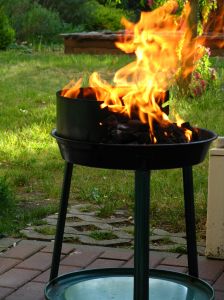
But did you know that, in addition to ruining the flavor, meat that's been burned or blackened on the grill can be downright dangerous? Research conducted by the National Cancer Institute has shown that overcooking certain meats, such as beef, pork, fish, and chicken can lead to the production of various chemicals which were not present in the uncooked meats. Among the new chemicals produced, at least 17 of them were found to lead to a sharply increased risk of cancer. The National Cancer Institute research looked at the eating habits of 679 people, 176 of which had been previously diagnosed with stomach cancer, and 503 who were considered to be cancer-free. Among those who ate meat cooked medium-rare or rare, the risk for stomach cancer was three times lower than among those who had habitually eaten overcooked “well-done” meats.
These carcinogenic chemicals that form when meats are overcooked are known as HCAs, or heterocyclic amines. They are produced when a high-temperature chemical reaction is caused between the creatine found in muscle tissue and the amino acids that form the basis of all proteins, a reaction that is extremely likely to occur given the high temperatures involved in grilling.
That's not all, though. In addition to HCAs, a second type of cancer-causing chemical known as PAHs, or polycyclic aromatic hydrocarbons is a real problem too. Of all the PAHs that are naturally occurring in our environment, 18 are are known to be produced when the fats from meat drip down onto the heat source and produce a type of soot that blackens the outside of the meat and produces an unpleasant film and taste.
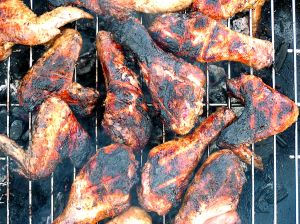
So far, research has only shown the carcinogenic chemicals associated with grilling to be produced by cooking muscle meats. Organ meats such as liver and kidneys, or other types of “dairy” protein such as eggs and milk contain little to no creatine, and so the chemical process by which HCAs are produced never occurs.
Keep in mind that it's the fat dripping onto the heat source that causes the production of PAHs. Using a leaner cut of meat can drastically reduce this problem or even come close to eliminating it all together. Pork ribs seem to be among the worst cuts of meat to grill in terms of the high number of PAHs produced. By comparison, chicken or turkey breasts are among the best.
Safe grilling tips to reduce cancer risk
Certain types of cooking are known to cause a greater production of HCAs and PAHs than others. Frying, broiling, and barbecuing involve the highest temperatures among all cooking methods because they bring the food into direct or close contact with open flames or boiling fats. By contrast, cooking methods such as baking or over roasting involve much lower temperatures and thus are considered to be significantly safer. Boiling, poaching, and stewing involve the lowest cooking temperatures of all, however, and the amount of HCA's produced by those methods is so low as to be insignificant.
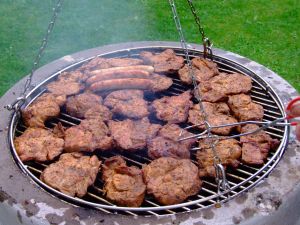
At this point, you're probably ready to hang up the apron and tongs, go inside, and grab the stock pot, but not so fast! You set out to grill, and short of swearing off cookouts forever, these problems will have to be confronted sooner or later. The good news is that it is possible to grill out and have fun doing it even while keeping all these dangers in mind. As real as the dangers are, there are some simple steps that you can take to reduce the risk at your next family cookout.
Grillint Tip #1: Prepping the Grill
In order to prepare the grill for maximum flavor as well as protect ourselves against carcinogens, we'll have to take a few extra steps. First, we'll need to clean all the soot and particles off our grill for the same reason that we don't want it on our meats. For that, you'll need a good quality stiff wire brush. It's much easier to clean a grill after it's been used than before, so unless you cleaned the grill thoroughly after last using it, you'll need to heat up the grill before you cook on it. After it starts to cool, but while it's still somewhat warm, you'll find it easiest to clean. It's okay to use simple soap and water for any burnt on or stubborn particles or discoloration.
About once a year, though, you're going to need to give your grill a really good deep cleaning. For charcoal grills, simply empty out all the old coals and ash, remove the rack, and really scrape out all the gunk that has accumulated on the bottom of the grill itself. If you see any rust or patches where paint has come off, you should touch up the area with grill-safe paint that can be purchased at any hardware store. For gas grills, things will probably get a bit more complicated. You'll likely need to take certain pieces of the grill apart in order to reach the burners, which you'll need to inspect very thoroughly. Check for anything that might be obstructing the flow of gas. If you have a grill that uses ceramic plates or lava rock, make certain that there's no build-up of residue or cooked-on foods. Again, touch up any rusted or unpainted areas with a fresh application of grill-safe paint.
Keeping your grill clean might seem like common sense, but it's actually more important than most realize. Clogged burners or a build-up of old food residue can cause uneven grilling, and even triple the amount of smoke output that you'd normally have while grilling. Since even heat distribution will help prevent overcooking, and smoke is one of the primary causes of PAH production, it's crucial to make certain the grill is cleaned after each usage, and then thoroughly inspected at least once a year, usually at the start of summer.
Grilling The Perfect Steak
Grilling Tip #2: Prepping the Meat
As important as grill maintenance and setup is, there are even more precautions that you can take with the meat itself to safeguard yourself against the production of cancer-causing agents. Studies have shown that slightly precooking meats in a microwave oven will sharply reduce the number of HCAs present after cooking. All you'll need to do is microwave the meat for roughly two minutes prior to cooking. Place the meat in a large, deep dish because precooking will not only lower cooking time (thus reducing the amount of time the meat is exposed to high temperatures and smoke), but it also produces a large amount of liquid that will need to be poured off before transferring the meat to the grill. Many like to use drippings of this type to make gravies or sauces, and while this is a long-standing tradition, it has been shown that such sauces inevitably contain a very high amount of HCAs, so use your own judgment.
Another important thing to consider is the thickness of the meat you'll be cooking. It's generally thought that cuts thicker than 1 to 1.5 inches are unsafe for grilling because the amount of time required to cook the inside to the appropriate temperature will usually cause the outside of the meat to become overcooked, exposing us to all kinds of dangers. If you're slicing your own cuts of beef or pork, keep this in mind. If you're buying them from a butcher's, simply ask if you can have them more thinly sliced. Particularly plump chicken breasts can be split in half prior to grilling or pounded into a larger, yet thinner shape.
Grilling Safeguards
Once you've prepared the meat and you're ready to actually get to grilling, there are a few things to keep in mind. First is that you should always let coals burn down to a steady glow with no active flames before placing the meat on the rack. For both gas and charcoal grills, the rack should always be placed at least six inches above the heat source for best results. Anything at all that you can do to reduce the amount of direct contact between the meat and flame or smoke, the lower the amount of carcinogenic agents will be produced and the safer your food will be to eat.
Because smoke is the main danger where PAHs are concerned, consider using a drip pan or a strategically placed sheet of aluminum foil to catch and collect fat drippings before they come into contact with the heat source. This will not only make the food safer, but it'll reduce blackening and also make your grill easier to clean when the day is over. You might want to scrap meats that become significantly charred, or at the very least trim away the blackened areas.
If you precook the meat in the microwave, it might be the case that you'll lose a bit of moisture in the process. However, there's an easy way to counteract this problem. Brushing a coating of light cooking oil or a thick sauce onto the meat will help insulate it against the heat and retain the internal juices, ensuring a moist and flavorful finished product. In particular, sauces containing honey, cherries, or tomatoes seem to be the best at holding in moisture and preventing charring. If you want to go even further, it's possible to purchase a special foil bag for grilling that holds the meat inside, along with a flavorful marinade. Using one of these will not only keep even precooked meat moist, but sharply reduce the contact the food has with smoke or flame. Bear in mind though, that even meat inside a foil bag will need to be turned or else it's in danger of burning.
Using a meat thermometer will be a big help in cooking the meat for just the right amount of time, so you won't have to worry about overcooking. For medium-rare results, cook beef steaks to an internal temperature of 130 to 140 degrees F. Ground beef, however, will have to be cooked to a minimum of 155 degrees for the sake of killing all bacteria. Pork cutlets should be cooked to an internal temperature of 160 degrees F, and chicken is done when it reaches 165. As for fish, don't worry so much about the temperature, but instead simply cook it until it begins to get flaky.
While studies indicate that the prevalence of HCAs and PAHs in the foods we eat are a very real danger and demonstrably lead to an increased risk of certain types of cancer, a little cleanliness and common sense will go a long way towards reducing these risks. If you follow the above guidelines, there's no reason why you shouldn't be able to enjoy a safe, worry-free cookout with your friends and family, no matter what's on the menu. Happy grilling!
Other useful hubs
- Macaroni Grill Copycat Recipes
Romano's Macaroni Grill bills itself as a chain of casual Italian dining restaurants located around the world. The first Romano's Macaroni Grill opened in Texas in 1988. They make great Italian dishes. And... - How To Grill Hamburgers
It's hamburger night in Baton Rouge. The LSU Tigers are in baseball post season. And we're celebrating. Bobby Flay, Tyler Florence, Al Roker - these are just a few names in the BBQ and grilling realm. Many... - Grilled corn three ways.How to best grill sweet corn on the cob. Perfect summer BBQ food!
Ah sweet sweet corn on the cob. Summer's perfect vegetable, and a great excuse to eat loads of butter and salt! There is absolutely nothing wrong with a beautiful steamed or boiled cob of corn, and... - How To Grill Steaks
Steak and Potatoes - the perfect mans meal. What makes a perfect steak? First you must start off with quality meat from your local butcher or meat market. Ideally, they specialize in quality meat and can... - Yes, YOU can earn the title "Master of the Grill" with these 56 dry rub recipes
Twenty years ago only the cooking pros knew about - and used - dry rubs for meat. Now, it's the hottest trend in grilling, in baking, or even just cooking on top of the stove. The theory is easy... mix... - Macaroni Grill Copycat Recipes
Romano's Macaroni Grill bills itself as a chain of casual Italian dining restaurants located around the world. The first Romano's Macaroni Grill opened in Texas in 1988. They make great Italian dishes. And... - How To Grill Hamburgers
It's hamburger night in Baton Rouge. The LSU Tigers are in baseball post season. And we're celebrating. Bobby Flay, Tyler Florence, Al Roker - these are just a few names in the BBQ and grilling realm. Many... - Grilled corn three ways.How to best grill sweet corn on the cob. Perfect summer BBQ food!
Ah sweet sweet corn on the cob. Summer's perfect vegetable, and a great excuse to eat loads of butter and salt! There is absolutely nothing wrong with a beautiful steamed or boiled cob of corn, and... - How To Grill Steaks
Steak and Potatoes - the perfect mans meal. What makes a perfect steak? First you must start off with quality meat from your local butcher or meat market. Ideally, they specialize in quality meat and can... - Yes, YOU can earn the title "Master of the Grill" with these 56 dry rub recipes
Twenty years ago only the cooking pros knew about - and used - dry rubs for meat. Now, it's the hottest trend in grilling, in baking, or even just cooking on top of the stove. The theory is easy... mix... - Macaroni Grill Copycat Recipes
Romano's Macaroni Grill bills itself as a chain of casual Italian dining restaurants located around the world. The first Romano's Macaroni Grill opened in Texas in 1988. They make great Italian dishes. And... - How To Grill Hamburgers
It's hamburger night in Baton Rouge. The LSU Tigers are in baseball post season. And we're celebrating. Bobby Flay, Tyler Florence, Al Roker - these are just a few names in the BBQ and grilling realm. Many... - Grilled corn three ways.How to best grill sweet corn on the cob. Perfect summer BBQ food!
Ah sweet sweet corn on the cob. Summer's perfect vegetable, and a great excuse to eat loads of butter and salt! There is absolutely nothing wrong with a beautiful steamed or boiled cob of corn, and... - How To Grill Steaks
Steak and Potatoes - the perfect mans meal. What makes a perfect steak? First you must start off with quality meat from your local butcher or meat market. Ideally, they specialize in quality meat and can... - Yes, YOU can earn the title "Master of the Grill" with these 56 dry rub recipes
Twenty years ago only the cooking pros knew about - and used - dry rubs for meat. Now, it's the hottest trend in grilling, in baking, or even just cooking on top of the stove. The theory is easy... mix...
This hub brought to you...
by Julie-Ann Amos, professional writer, and owner of international writing agency www.ExquisiteWriting.com
Why not create your own HubPages? It's fun and you can make revenue from Adsense and other revenue streams on your pages. JOIN HUBPAGES NOW
This work is licensed under the Creative Commons Attribution-Non-Commercial-No Derivative Works 3.0 Unported License. To view a copy of this licence, visit http://creativecommons.org/licenses/by-nc-nd/3.0/ or send a letter to Creative Commons, 171 Second Street, Suite 300, San Francisco, California 94105, USA.


